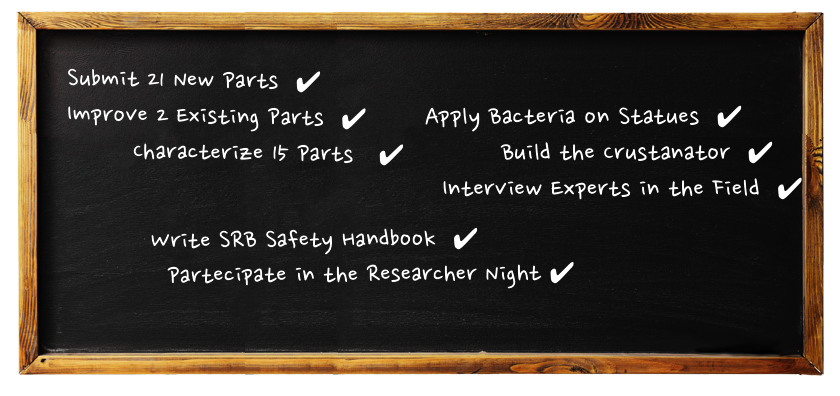Team:UNITN-Trento
From 2012.igem.org
| Line 196: | Line 196: | ||
<p>Statues and monuments all over the world are not enjoyed to the extent that they should be because they are covered in a disfiguring black crust, which consists mainly of CaSO4. <br /> | <p>Statues and monuments all over the world are not enjoyed to the extent that they should be because they are covered in a disfiguring black crust, which consists mainly of CaSO4. <br /> | ||
A practical solution would be if a cheap mechanism was available to continually remove the pollutant molecules that adhere to the surface of statues. To build such a system, we are engineering an aerobic sulfur reducing pathway in E. coli to dissolve the disfiguring black crusts.</p> | A practical solution would be if a cheap mechanism was available to continually remove the pollutant molecules that adhere to the surface of statues. To build such a system, we are engineering an aerobic sulfur reducing pathway in E. coli to dissolve the disfiguring black crusts.</p> | ||
| - | <span class="more"><a href=" | + | <span class="more"><a href="https://2012.igem.org/Team:UNITN-Trento/Project/CrustAway">Read More <span class="arrow">→</span></a></span> |
</div> | </div> | ||
<div class="two" style="margin-right: 0; width: 48%;"> | <div class="two" style="margin-right: 0; width: 48%;"> | ||
| Line 203: | Line 203: | ||
Also, the compatibility between T7 and E. coli derived parts has not been explored. | Also, the compatibility between T7 and E. coli derived parts has not been explored. | ||
To better understand the compatibility of the two systems and to begin to better characterize T7 biological parts, we are measuring the termination efficiencies of T7 and E. coli transcriptional terminators with E. coli and T7 RNA polymerases. </p> | To better understand the compatibility of the two systems and to begin to better characterize T7 biological parts, we are measuring the termination efficiencies of T7 and E. coli transcriptional terminators with E. coli and T7 RNA polymerases. </p> | ||
| - | <span class="more"><a href=" | + | <span class="more"><a href="https://2012.igem.org/Team:UNITN-Trento/Project/Terminators">Read More <span class="arrow">→</span></a></span> |
</div> | </div> | ||
</div> | </div> | ||
Revision as of 15:34, 23 September 2012
Saving the World, one statue at a time
Project Codename: Crust Away
Statues and monuments all over the world are not enjoyed to the extent that they should be because they are covered in a disfiguring black crust, which consists mainly of CaSO4.
A practical solution would be if a cheap mechanism was available to continually remove the pollutant molecules that adhere to the surface of statues. To build such a system, we are engineering an aerobic sulfur reducing pathway in E. coli to dissolve the disfiguring black crusts.
Project Codename: Terminator 5
Surprisingly little standardization of T7 phage derived parts has occurred, despite the prevalence of T7 parts in recombinant technologies. Also, the compatibility between T7 and E. coli derived parts has not been explored. To better understand the compatibility of the two systems and to begin to better characterize T7 biological parts, we are measuring the termination efficiencies of T7 and E. coli transcriptional terminators with E. coli and T7 RNA polymerases.
Read More →MEET THE TEAM

ACHIEVEMENTS

 "
"












